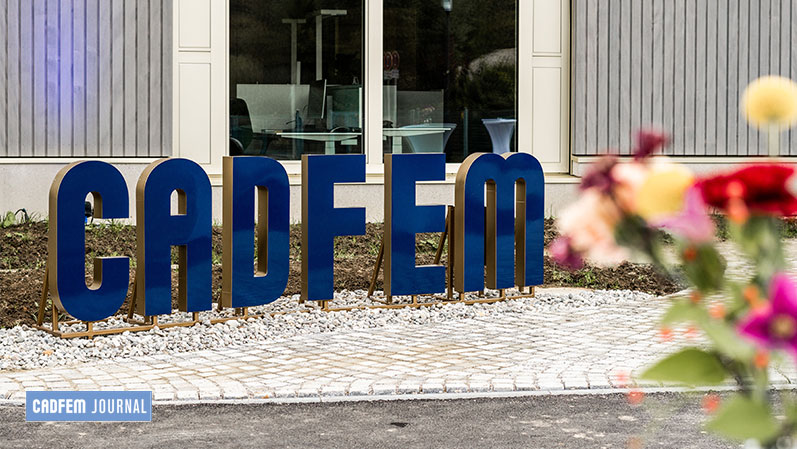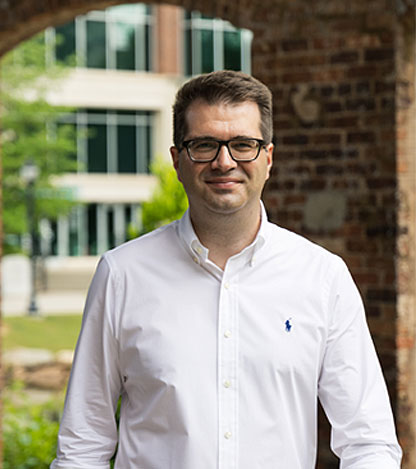Interview with CADFEM Managing Director Matthias Alberts
“Integrating simulation into the value-added process.”
Matthias Alberts was appointed Managing Director of CADFEM Germany GmbH in mid-2022. In this interview, he outlines where the CADFEM journey is heading. He addresses the changes the engineering world has to deal with, the opportunities that drive CADFEM customers, why simulation is also an issue for board members, and what that means for a company like CADFEM.


Matthias, you have been managing director of CADFEM Germany for one year now. What is your first impression?
Very positive. We have a good ambitious team, and our customers are increasingly experiencing the added value of simulation, even outside of purely technical product development. Overall, we can see that our customers want to make a difference and tap into new markets, which of course makes me happy.
Let’s go back a little bit. You joined CADFEM 15 years ago. What have been the biggest changes?
For one, there are the technical possibilities of simulation, which have developed enormously. Today, simulation covers a much broader spectrum. We also see this with our partner Ansys and the development of the product portfolio.
In discussions with our customers, it is also becoming increasingly apparent that simulation is gaining importance within companies. Fifteen years ago, simulation was left to technical experts. In many respects, it certainly still is today. However, we are seeing a change. Nowadays, it can be seen on the screens of board members and managing directors. Not as a technical fringe topic, but rather in the sense of implementing virtual product development, in connection with digitalization or in the development of new data-based business models.
I recently had a conversation with one of our customers, where the board of directors initiated a multi-year “digital prototype” project. We are very excited about this!
What does this mean for the topic of simulation?
This is a question we have repeatedly asked ourselves over the past few months. While simulation as part of digitalization has become an important building block for many companies, its real added value for our customers only comes into play when it fuels digital engineering and is an integrated part of the value-added chain.
If you want to achieve this, you can’t look at the simulation process in isolation; you have to integrate simulation profitably into the company’s processes.

Matthias Alberts
… started his professional career in 2007 at CADFEM in Hannover as a computational engineer. This was followed by various duties at CADFEM in Germany and abroad. He has been managing director of CADFEM (Austria) GmbH for many years and since July 2022 also of CADFEM Germany GmbH.
How does Ansys deal with this?
Ansys has recognized that simulation can no longer be an isolated solution in a company’s development environment. In recent years, Ansys has ensured through acquisitions and partnerships that we are able to integrate simulation into our customers’ processes as an added value. This affects many aspects in the company, from system simulation to process integration to cloud solutions.
What does this mean for CADFEM?
Our task is to successfully implement the possibilities of simulation as well as the integration into existing and new processes at our customers. We have to ensure that the respective users of our customers are able to apply simulation as efficiently as possible. The prerequisites for this are always different. The IT systems and development processes as well as the technical knowledge are almost always individual. The customer wants complete solutions, integrated into their processes.
How does CADFEM respond to this?
We need to truly understand our customers in order to offer them an ideal package of software, integration, IT solutions and training. On the subject of training, we have invested in eLearning formats and online training, which are being very successfully adopted today. We will continue to push the expansion of hybrid training options in the coming years.
In the field of IT solutions, we enable our customers to use both local and cloud solutions and their interaction. In addition, we will further expand the entire field of automation of simulation processes and integration into existing development processes. This extends to the development of customized Ansys-based simulation solutions.
We will also invest in the interaction of simulation and artificial intelligence. We want to further expand collaboration within the CADFEM Group worldwide. And for our employees, we want to remain an attractive workplace.
What’s in it for the customer?
The first step was to understand how our customers and the market will develop. To do this, we conducted many discussions, interviews, and surveys over the past few months. Today, we have a very good understanding of the issues that concern our customers.
This ranges from material and energy savings, to differentiation in the market, to more effective product and process development, to challenges around increasing product complexity. With automated simulation solutions, companies can counter the shortage of skilled workers, for example. Digital twins can be used to implement topics such as predictive maintenance, thus opening up new business areas.
We do this, for example, together with ITficient, one of our sister companies within the CADFEM Group. Simulation solutions can be used to optimize the use of materials and energy.
Are there any examples you can talk about where this alignment already exists?
A great example is RAUCH Furnace Technology, who is implementing a digital twin of a melting crucible with support from ITficient and CADFEM. The cooperation with Krones in the realization of a software solution for simulation by design engineers is another nice example of the integration of simulation into the entire company process.
In the last CADFEM Journal, we reported about our cooperation with Liebherr. Here, too, there are many common and successful examples. In the future, there will be more for us and our customers.
Contact CADFEM






